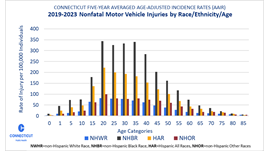Motor Vehicle Injury Prevention
Motor Vehicle Injury is injury from crashes with 2-, 3-, and 4-wheel motorized vehicles, heavy trucks, and buses that includes crash-related injury to pedestrians and cyclists.
Prevention Activities in Connecticut focus on reducing impaired, distracted, and aggressive driving while improving pedestrian, bicycle, and motorcycle safety, child passenger safety, teen drivers, older adult drivers, and speeding.
Equity in Health is important to transportation safety. Social, environmental, and economic factors are typically not reported with a transportation injury, making inequities difficult to assess. It is understood in Connecticut, middle-aged non-Hispanic Blacks and Hispanics of all races carry the greatest burden of risk for both fatal and non-fatal crash-related injuries.


click to enlarge click to enlarge
Important steps for transportation safety:
- Always wear a seat belt;
- Properly use and install car seats and booster seats appropriate for the age and size of each child;
- Wear helmets when cycling (bicycle and motorcycle);
- Drive without distractions;
- Drive without impairment from drugs, including alcohol and marijuana;
- Assist impaired drivers to find alternate transportation;
- When walking, face oncoming traffic and if walking at night, wear highly visible reflective clothing
visit http://www.ctsafekids.org/fittingstations.html for a fitting station near you.
Important steps for parents with teens :
- Learn and enforce Connecticut's teen driving laws;
- Discuss the rules of the road with your teen;
- Create a parent-teen safe driving contract that includes high-risk behaviors;
- Monitor your teen's driving habits.
Connecticut Department of Transportation Crash Emphasis Dashboard

Vision Zero is an international, human-centric transportation safety initiative of adopting the long-term policy goal that no-one should be killed or seriously injured in a crash. Vision Zero embraces a Safe System Approach of safer people, safer vehicles, safer speeds, safer roadways, and optimal post-crash care.
The Connecticut Vision Zero Council as established by the Connecticut General Assembly in 2021, is an interagency work group tasked with developing statewide policy to eliminate transportation-related fatalities and severe injuries involving pedestrians, bicyclists, transit users, motorists, and passengers.
Preventive Health and Health Services Block Grant
The Preventive Health and Health Services Block Grant (PHHSBG) provides all 50 states, the District of Columbia, 2 American Indian tribes, and 8 US territories with funding to address their unique public health needs in innovative and locally defined ways. This program gives grantees the flexibility to use funds to respond rapidly to emerging health issues and to fill funding gaps in programs that deal with leading causes of death and disability.
Highway Safety Office Annual Plans and Reports
The Connecticut Department of Transportation's Highway Safety Office (HSO) develops and updates annual highway safety plans and reports which can be accessed here. The Office coordinates highway safety initiatives for the priority areas of impaired driving, distracted driving, speed and aggressive driving, public information and education, bicycle and pedestrian safety, teen driving, highway safety-related legislation, police traffic services, Drug Evaluation and Classification Program (DECP), occupant protection, and child passenger safety.
Strategic Highway Safety Plan Executive Committee
Connecticut has worked diligently to address the issue of transportation-related injuries and deaths through strong leadership and public agency support of highway safety initiatives and partnerships with not-for-profits, private businesses, and Connecticut citizens. The Strategic Highway Safety Plan (SHSP) Executive Committee and Steering Committee—made up of these partners—have worked to reduce needless loss of life, and each life saved moves us in the direction of our long-term vision. The safety culture of these partners and Connecticut’s road users is vital to prevent future roadway fatalities and serious injuries (Excerpt from Executive Summary, CT SHSP, 2017-2021). To view the current SHSP, click here.
Links:
Motor Vehicle Injury in Connecticut - A Fact Sheet - 2021 Update
Motor vehicle crash injuries in the US: Costly but preventable - http://www.cdc.gov/vitalsigs/pdf/2014-10-vitalsigns.pdf
Cost of deaths from motor vehicle crashes in Connecticut- http://www.cdc.gov/Motorvehiclesafety/pdf/fatal_crash_cost/ct_costofcrashdeaths.pdf
Adult Seat Belt Use in the US: http://www.ct.gov/dph/lib/dph/hems/injury/seatbeltuse_factsheet.pdf
Child Passenger Safety: http://www.cdc.gov/vitalsigns/pdf/2014-02-vitalsigns.pdf
For more information, please call
The Office of Injury and Violence Prevention
(860) 509-8251

